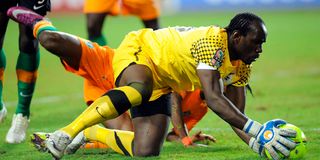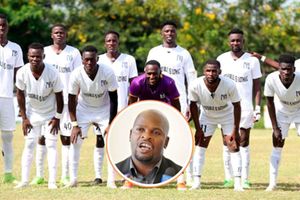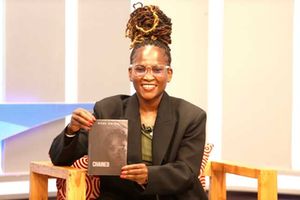
Internacional and Juventude players walk into the pitch at Estadio Jose Pinheiro Borda, Porto Alegre, Brazil on April 26, 2025.
Trusted with wearing the armband, captains inspire as they stand at the front of the team’s line in the tunnel before kick-off.
They epitomize the timeless tradition of commanders leading their troops to war and that makes them immune to the interesting intricacies that influence the order in which the other players follow them to the pitch.
These intricacies create new ranks in teams as peculiar dressing room behaviours interact with jersey numbering conventions, alignment of tactical formations, psychological nuances, and the after effects of warm up sessions to cement another enduring tradition of pre-match walk-outs by football teams – that of goalkeepers.
When these man who stand between the sticks are not wearing the armband, they mostly shadow their captains when marching out of the tunnel.
At least those are the reasons that Nairobi City Stars goalkeeper Edwin Mukolwe gave when asked why goalkeepers, guardians of the loneliest job in football, often trail their captains when walking out of the tunnel.
“I see it as a long-standing culture. I suppose it arises from the perception of goalkeepers as leaders. I also think jersey numbers and tactical formations being ordered according to playing positions – goalkeepers first, then defenders, followed by midfielders, and finally strikers – contribute to that as well. Hence, if there is a player who will be expected to follow the captain out of the tunnel then it would be the goalkeeper,” Mukolwe says.
However, Mukolwe also admits that the practice is not cast in stone. “I have never interacted with any rule that stipulates the goalkeeper should be the second one out of the tunnel if they are not the captain of their team,” he says.
It is a view shared by his Bandari FC counterpart, Faruk Shikhalo, who says: “as long as I am behind the captain, I can stand anywhere I want in the line depending on how I feel before the game.”
Former Harambee Stars goalkeeper Wilson Obungu also expressed a similar view. Now the goalkeeper trainer at Sofapaka FC, during his playing days, Obungu’s love for Rhumba music made him delay his exit from the dressing room to line up in the tunnel.

Wilson Obungu in action during a Kenyan Premier League match between Sofapaka and Sony Sugar at Nairobi City Stadium on October 23, 2009.
“I listened to music to psyche myself up before matches and I would wait for a song to end before I line up in the tunnel,” Obungu says. “When I finally joined the queue, I preferred being third or fourth in the line,” he adds.
Badir Yassin, a FKF Premier League referee, backs the trio’s assertion on there being no rule that guides how players should line up behind their captain in the tunnel.
“As long as the two captains are leading queues of 11 players, referees have no business caring how the other players line up behind them. We only care about them lining up on time while in proper playing kits,” Yassin says.
However, moving on to the other factors that influence the practice, Mukolwe explains aspects of dressing room dynamics and aftermath of warm up sessions that perpetuate the practice.
Due to the nature of their job, goalkeepers start and end their warm up sessions earlier than outfield players.
“Unlike for outfield players, our warm up sessions are longer and more intense because they involve full body workouts,” he says.
“Other than footwork and tactical awareness drills, goalkeepers also require ball handling exercises that involve saving shots taken from different angles and distances. We also release them early to cool down and change to their playing kits,” Obungu says.
As a result, by the time outfield players join the goalkeepers in the dressing room after completing their warm up sessions, they find them changed to their playing kits or in winding up their changing.
It is the return of the outfield players to the dressing room, as Mukolwe explains, that ushers in the playing out of dressing room dynamics that finally determine the order in which the players will enter the pitch.
“Some players take a longer time to get dressed than others while star players, mostly forwards and attacking midfielders, deliberately delay their exit from the dressing room because they prefer joining the line last. They like creating suspense with their late entrance to receive the loudest cheer from the crowd. Unfortunately for goalkeepers, we rarely command such star appeal,” he says.
Still, while a review of video clips from football matches played over the last 75 years offer strong support for Mukolwe’s claim of the practice having a long tradition, the video clips also provide solid evidence to back Obungu’s and Shikhalo’s opinions on the subject – a goalkeeper can stand anywhere in the line and even revel in the attention of a late entrance.
The video clips reviewed are from Fifa World Cup finals played since 1954 and Afcon finals from 2000.
The two competitions play a key role in influencing new cultural trends in football regionally and globally.
On this subject, Afcon finals have played a key role in upholding the practice as only the 2012 Afcon final is an exception.

Zambia's goalkeeper Kennedy Mweene during the 2012 African Cup of Nations final against Côte d'Ivoire on February 12, 2012 at the Stade de l'Amitie in Libreville.
Kennedy Mweene, Zambia’s penalty shoot-out hero in that final which ended 0-0 after regulation and extra time, was the last Chipolopolo player out of the tunnel. Interestingly, his Cote d’Ivoire counterpart, Boubacar Barry, made his strides to the pitch ahead of only Kolo Toure who had a reputation of entering the pitch last for superstitious reasons.
Coming to World Cup finals, the competition tells a tale of two centuries in terms of upholding the practice.
The competition had seven exceptions to the trend in the 12 World Cup finals played before 2000. However, in the six World Cup finals played since then, only three goalkeepers – Marcos of Brazil in 2002 (third), Gianluigi Buffon of Italy in 2006 (seventh), and Sergio Romero of Argentina in 2014 (last) – went against the grain.

Juventus' goalkeeper Gianluigi Buffon gestures at the end of the Italian Serie A football match between Juventus and Sassuolo on February 4, 2018 at the 'Allianz Stadium' in Turin.
With fewer deviations noticed in the practice at Afcon and World Cup finals since 2000, it can be argued that rigid tunnel order is increasingly becoming the norm.
However, there were exceptions at the ongoing 2025 Under-20 Afcon where Kenya’s Rising Stars exited at the group stage.
From the first 18 matches, only two fixtures witnessed a goalkeeper walking several players behind the captain. Interestingly, the two cases involved Rising Stars and Tanzania.
While Wycliffe Oduor walked out of the tunnel last when Kenya played Nigeria in their last group match, Mpank Bomboma was fourth in Tanzania’s file when they entered the pitch to play Sierra Leone.
Yet even with no rule preventing goalkeepers from standing where they want when teams line up in the tunnel, their right to exercise free will is taken away from them in video games.
Eric Ngige, a two-time Kenyan eLigue1tour champion, attests to that peculiarity of virtual football matches.
“Even though video games are designed to imitate reality, it fails on this subject. Not unless they are the captain, goalkeepers always follow their captains out of the funnel in virtual football matches,” Ngige says. “There are no controls video game players can use to change that,” he adds.
Ngige’s comments introduce a fascinating view to this subject. His opinion confirms that however much programmers of football video games attempt to imitate reality, there are aspects of human behaviour they cannot fully simulate.
While those same aspects of human behaviour continue to conspire to make the sight of goalkeepers following their captains out of the tunnel increasingly common, they are not binding enough to prevent rare moments where a goalkeeper revels in the dramatic flair of a late entrance like Wycliffe Oduor did when the Rising Stars played Nigeria U20 in their final group game at the 2025 Afcon Under-20 tournament.







